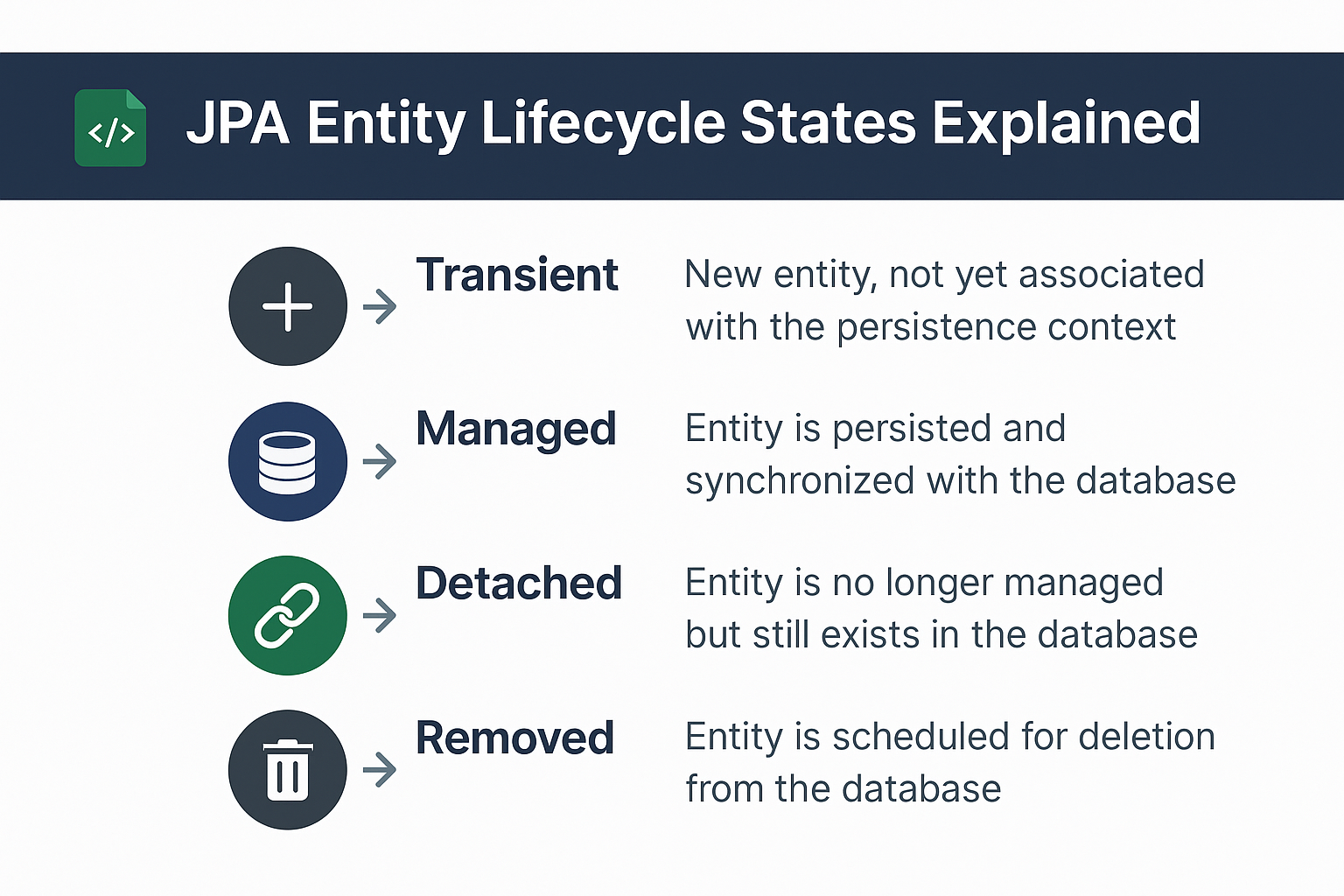Understanding entity lifecycle states is essential for mastering JPA (Java Persistence API). These states — Transient, Managed, Detached, and Removed — define how JPA entities interact with the Persistence Context and the database.
In this tutorial, we’ll break down each lifecycle state with examples, explain how the EntityManager manages transitions, and share best practices for avoiding pitfalls in production systems.
What are JPA Entity Lifecycle States?
Entities in JPA can exist in one of four states:
- Transient → Entity is created but not tracked by Persistence Context.
- Managed (Persistent) → Entity is being tracked and synchronized with DB.
- Detached → Entity was managed but is no longer tracked.
- Removed → Entity is marked for deletion in DB.
Analogy: Think of Persistence Context as a classroom register. Students (entities) are either not enrolled (Transient), actively tracked (Managed), absent but known (Detached), or marked as dropped (Removed).
Persistence Context Configuration
Defined in persistence.xml:
<persistence xmlns="https://jakarta.ee/xml/ns/persistence" version="3.0">
<persistence-unit name="examplePU">
<class>com.example.model.User</class>
<properties>
<property name="jakarta.persistence.jdbc.driver" value="org.h2.Driver"/>
<property name="jakarta.persistence.jdbc.url" value="jdbc:h2:mem:testdb"/>
<property name="jakarta.persistence.jdbc.user" value="sa"/>
<property name="jakarta.persistence.jdbc.password" value=""/>
<property name="hibernate.dialect" value="org.hibernate.dialect.H2Dialect"/>
<property name="hibernate.hbm2ddl.auto" value="update"/>
<property name="hibernate.show_sql" value="true"/>
</properties>
</persistence-unit>
</persistence>
Example Entity
import jakarta.persistence.*;
@Entity
@Table(name = "users")
public class User {
@Id
@GeneratedValue(strategy = GenerationType.IDENTITY)
private Long id;
private String name;
@Column(unique = true, nullable = false)
private String email;
// Constructors, Getters & Setters
}
Lifecycle States in Action
1. Transient State
- Entity is created but not associated with Persistence Context.
User user = new User("Alice", "alice@example.com"); // Transient
2. Managed (Persistent) State
- Entity becomes managed when persisted.
- Any changes are tracked and auto-synced (dirty checking).
em.getTransaction().begin();
em.persist(user); // Now Managed
user.setName("Alice Updated"); // Auto-detected
em.getTransaction().commit();
3. Detached State
- Entity is no longer managed.
- Happens when
em.detach(entity)orem.close()is called.
em.detach(user); // Detached
user.setName("Detached Alice"); // Not synced
To reattach:
em.getTransaction().begin();
em.merge(user); // Back to Managed
em.getTransaction().commit();
4. Removed State
- Entity marked for deletion.
- Deleted on transaction commit.
em.getTransaction().begin();
em.remove(user); // Removed
em.getTransaction().commit();
CRUD Operations and Lifecycle Transitions
EntityManagerFactory emf = Persistence.createEntityManagerFactory("examplePU");
EntityManager em = emf.createEntityManager();
// Transient
User user = new User("Bob", "bob@example.com");
// Persist → Managed
em.getTransaction().begin();
em.persist(user);
em.getTransaction().commit();
// Detach → Detached
em.detach(user);
// Merge → Back to Managed
em.getTransaction().begin();
em.merge(user);
em.getTransaction().commit();
// Remove → Removed
em.getTransaction().begin();
em.remove(em.find(User.class, user.getId()));
em.getTransaction().commit();
Queries and Persistence Context
JPQL Example
List<User> users = em.createQuery("SELECT u FROM User u WHERE u.name = :name", User.class)
.setParameter("name", "Alice")
.getResultList();
Criteria API Example
CriteriaBuilder cb = em.getCriteriaBuilder();
CriteriaQuery<User> query = cb.createQuery(User.class);
Root<User> root = query.from(User.class);
query.select(root).where(cb.equal(root.get("email"), "alice@example.com"));
List<User> results = em.createQuery(query).getResultList();
Fetching Strategies and Lifecycle States
- Lazy (default) → Loaded on demand.
- Eager → Loaded immediately.
@OneToMany(mappedBy = "user", fetch = FetchType.LAZY)
private List<Order> orders;
Performance Considerations
- Managed entities reduce unnecessary queries (dirty checking).
- Detached entities can cause LazyInitializationException.
- Use JOIN FETCH to avoid N+1 queries.
Common Pitfalls
- Closing EntityManager too soon → Entities become detached.
- Overusing eager fetching → Performance bottlenecks.
- Forgetting transactions → Persist/merge operations fail.
Best Practices
- Keep EntityManager scope aligned with transaction scope.
- Prefer lazy fetching with selective eager loading.
- Use DTOs for read-only queries.
- Manage detached entities carefully with
merge().
📌 JPA Version Notes
- JPA 2.0 → Introduced Criteria API, Metamodel.
- JPA 2.1 → Added stored procedures, entity graphs.
- Jakarta Persistence (EE 9/10/11) → Migrated from
javax.persistence→jakarta.persistence.
Real-World Integrations
Spring Boot
@Repository
public interface UserRepository extends JpaRepository<User, Long> {
List<User> findByEmail(String email);
}
Jakarta EE
@Stateless
public class UserService {
@PersistenceContext
private EntityManager em;
public void saveUser(User user) {
em.persist(user);
}
}
Conclusion and Key Takeaways
- JPA entities transition through Transient, Managed, Detached, and Removed states.
- The Persistence Context ensures synchronization between objects and DB.
- Managed entities benefit from dirty checking.
- Use
merge()wisely to handle detached entities. - Avoid eager fetching unless necessary for performance.
FAQ
1. What’s the difference between JPA and Hibernate?
JPA is a specification; Hibernate is an implementation.
2. How does JPA handle the persistence context?
It tracks entity states and syncs changes with the database.
3. What are drawbacks of eager fetching?
It loads unnecessary data, hurting performance.
4. How can I solve the N+1 select problem?
Use JOIN FETCH or entity graphs.
5. Can I use JPA without Hibernate?
Yes, you can use EclipseLink, OpenJPA, or others.
6. What’s the best inheritance mapping strategy?SINGLE_TABLE for speed, JOINED for normalization.
7. How does JPA handle composite keys?
By using @EmbeddedId or @IdClass.
8. What changes with Jakarta Persistence?
Namespace moved from javax.persistence → jakarta.persistence.
9. Is JPA suitable for microservices?
Yes, but transactions should be short and efficient.
10. When should I avoid JPA?
For high-performance analytics or NoSQL systems.
